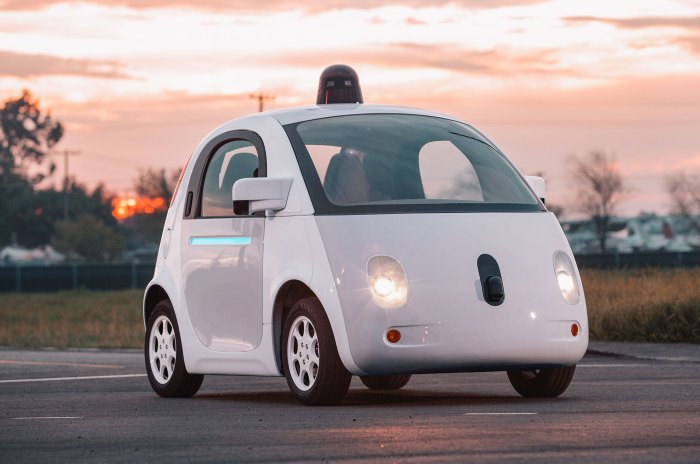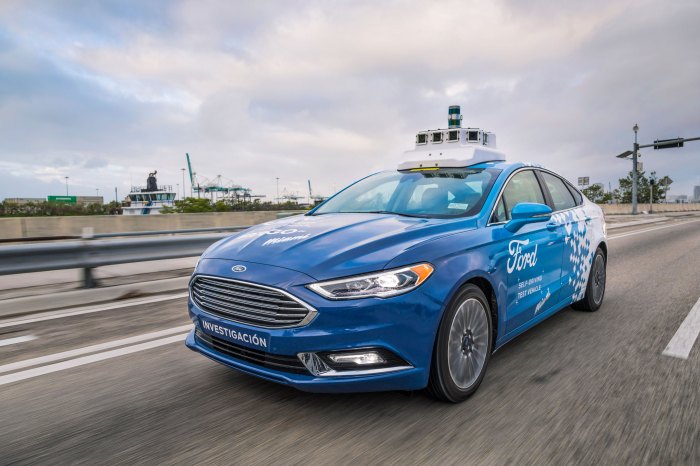Autonomous Vehicles are rapidly changing the landscape of transportation, promising a future where driving becomes a thing of the past. This technology, which involves vehicles capable of navigating and operating without human intervention, is driven by advancements in artificial intelligence, sensors, and software.
From navigating busy city streets to traversing challenging terrains, autonomous vehicles hold the potential to transform our lives in profound ways.
The history of autonomous vehicles stretches back decades, with early research and development efforts laying the foundation for the sophisticated systems we see today. The core of autonomous vehicle technology lies in a complex interplay of sensors, actuators, and sophisticated algorithms.
Sensors, such as lidar, radar, and cameras, gather data about the vehicle’s surroundings, while actuators, like steering wheels and brakes, respond to the algorithms’ instructions. The software itself is the brain of the operation, processing sensor data, making decisions, and controlling the vehicle’s movements.
Introduction to Autonomous Vehicles
Autonomous vehicles, also known as self-driving cars, are vehicles that can operate without human intervention. These vehicles use a combination of sensors, software, and actuators to perceive their surroundings, make decisions, and control their movement. The development of autonomous vehicles is a rapidly advancing field with the potential to revolutionize transportation.Autonomous vehicles are categorized into different levels of autonomy, defined by the Society of Automotive Engineers (SAE) International:
Levels of Autonomy
The SAE International defines six levels of autonomy:
- Level 0: No Automation: The driver controls all aspects of the vehicle’s operation.
- Level 1: Driver Assistance: The vehicle assists the driver with certain tasks, such as adaptive cruise control or lane keeping assist.
- Level 2: Partial Automation: The vehicle can perform some driving tasks, such as steering, accelerating, and braking, but the driver must remain attentive and ready to take over at any time.
- Level 3: Conditional Automation: The vehicle can perform all driving tasks in certain conditions, but the driver must be ready to take over if the vehicle encounters a situation it cannot handle.
- Level 4: High Automation: The vehicle can perform all driving tasks in most conditions, but a human driver may be needed in some situations.
- Level 5: Full Automation: The vehicle can perform all driving tasks in all conditions without human intervention.
History and Evolution
The concept of autonomous vehicles has been around for decades, with early prototypes dating back to the 1950s. However, significant progress in autonomous vehicle technology has occurred in recent years, driven by advancements in computing power, sensor technology, and artificial intelligence (AI).
- Early Prototypes (1950s-1970s): Early research and development focused on basic autonomous navigation capabilities, often in controlled environments.
- Advancements in Computing and Sensors (1980s-2000s): Advancements in computer processing power, sensor technology, and algorithms enabled more sophisticated autonomous systems.
- Modern Autonomous Vehicles (2010s-Present): The rise of AI and machine learning has led to significant breakthroughs in autonomous vehicle development, with companies like Google, Tesla, and Waymo leading the charge.
Key Components of an Autonomous Vehicle System
Autonomous vehicles rely on a complex system of interconnected components:
- Sensors: Autonomous vehicles utilize a variety of sensors to perceive their surroundings, including:
- Cameras: Provide visual information about the environment, including lane markings, traffic signs, and other vehicles.
- LiDAR (Light Detection and Ranging): Emits laser beams to measure distances and create a 3D map of the environment.
- RADAR (Radio Detection and Ranging): Uses radio waves to detect objects, regardless of weather conditions.
- Ultrasonic Sensors: Emit sound waves to detect objects in close proximity.
- Actuators: Actuators are responsible for controlling the vehicle’s movement based on the decisions made by the software:
- Steering System: Directs the vehicle’s wheels.
- Braking System: Applies brakes to slow down or stop the vehicle.
- Acceleration System: Controls the vehicle’s speed.
- Software: The software component is the brain of the autonomous vehicle, responsible for processing sensor data, making decisions, and controlling the actuators:
- Perception: Processes sensor data to understand the environment, including object detection, lane identification, and traffic sign recognition.
- Planning: Determines the optimal path for the vehicle to follow, considering factors such as traffic conditions, obstacles, and destination.
- Control: Executes the planned path by sending commands to the actuators to steer, brake, and accelerate the vehicle.
Benefits and Challenges

The introduction of autonomous vehicles (AVs) promises to revolutionize transportation, offering a range of potential benefits while also presenting significant challenges. Understanding both the advantages and drawbacks is crucial for the successful implementation and integration of AVs into our society.
Potential Benefits of Autonomous Vehicles
The potential benefits of autonomous vehicles are numerous and far-reaching. They can contribute to a safer, more efficient, and accessible transportation system.
- Increased Safety:AVs have the potential to significantly reduce road accidents, as they are not susceptible to human errors like fatigue, distraction, or impaired judgment. Studies have shown that human error is a contributing factor in over 90% of road accidents.
By removing human drivers from the equation, AVs could potentially lead to a dramatic reduction in traffic fatalities. For example, Waymo, a leading developer of AV technology, has reported a significant reduction in accidents involving its self-driving cars compared to human drivers.
- Reduced Traffic Congestion:AVs can communicate with each other and with traffic infrastructure, allowing for smoother traffic flow and reduced congestion. They can optimize their routes and speeds, minimizing unnecessary stops and delays. This can lead to shorter travel times and reduced fuel consumption, contributing to environmental sustainability.
- Improved Accessibility:AVs can provide transportation solutions for individuals who are currently unable to drive due to age, disability, or other limitations. They can offer door-to-door service, expanding mobility options for people with restricted mobility. This can enhance independence and quality of life for many individuals.
Challenges Associated with Autonomous Vehicles
While the potential benefits of AVs are significant, there are also several challenges that need to be addressed before they can be fully integrated into our transportation systems.
- Ethical Considerations:AVs face complex ethical dilemmas in situations where accidents are unavoidable. For example, in a scenario where an accident is inevitable, the AV needs to make a decision about who to harm. This raises ethical questions about how to program AVs to make such decisions and who is responsible for the consequences.
There is ongoing debate and research in the field of ethics and AI to develop guidelines and frameworks for addressing these challenges.
- Legal and Regulatory Frameworks:Existing traffic laws and regulations are not designed for autonomous vehicles. Clear legal frameworks need to be established to address issues such as liability, insurance, and data privacy. For instance, who is liable in the case of an accident involving an AV?
How will insurance policies be adapted for self-driving cars? These are critical questions that need to be addressed before widespread adoption of AVs.
- Public Acceptance:Public acceptance of AVs is crucial for their successful implementation. Many people have concerns about the safety, reliability, and ethical implications of self-driving cars. Building trust and confidence in the technology will require comprehensive public education, transparency, and demonstration of the benefits of AVs.
Impact of Autonomous Vehicles
The introduction of autonomous vehicles is expected to have a significant impact on various sectors of society, including the automotive industry, transportation systems, and the economy as a whole.
- Automotive Industry:AVs will disrupt the traditional automotive industry. There will be a shift from car ownership to mobility-as-a-service, with ride-hailing companies and AV manufacturers playing a central role. This could lead to job losses in the automotive manufacturing sector but also create new opportunities in software development, data analysis, and other related fields.
- Transportation Systems:AVs have the potential to transform transportation systems, making them more efficient and sustainable. They can optimize traffic flow, reduce congestion, and contribute to a decrease in greenhouse gas emissions. However, this will require significant infrastructure investments, including smart traffic systems, charging stations, and dedicated lanes for AVs.
- Society:The widespread adoption of AVs could have a profound impact on society. They could free up time for people who currently spend hours commuting, leading to changes in work patterns, leisure activities, and urban planning. The availability of affordable and accessible transportation could also lead to a more equitable society, providing opportunities for individuals who currently face transportation barriers.
Future Trends and Developments
The field of autonomous vehicles is constantly evolving, with advancements in technology driving the development of more sophisticated and capable systems. Several key trends and developments are shaping the future of autonomous vehicles, paving the way for a revolution in transportation and mobility.
Advanced Sensor Fusion
Sensor fusion plays a crucial role in enabling autonomous vehicles to perceive their surroundings accurately and make informed decisions. This involves integrating data from multiple sensors, such as cameras, lidar, radar, and ultrasonic sensors, to create a comprehensive understanding of the environment.
- Improved Accuracy and Reliability:By combining data from various sensors, autonomous vehicles can overcome the limitations of individual sensors, leading to more accurate and reliable perception. For example, lidar can provide precise distance measurements, while cameras can identify objects and their characteristics. This combined information allows the vehicle to make more informed decisions about navigation and obstacle avoidance.
- Enhanced Object Detection and Tracking:Sensor fusion enables autonomous vehicles to detect and track objects more effectively, even in challenging conditions such as low visibility or heavy traffic. By analyzing data from multiple sensors, the system can distinguish between different objects, such as pedestrians, vehicles, and obstacles, and predict their future movements.
- Real-Time Data Processing:Advancements in sensor fusion algorithms and processing power allow for real-time data analysis, enabling autonomous vehicles to respond quickly to changing environments. This is crucial for ensuring safe and efficient operation in dynamic traffic scenarios.
Improved AI Algorithms
Artificial intelligence (AI) is at the heart of autonomous vehicle technology, powering decision-making and navigation. The development of more advanced AI algorithms is essential for enhancing the capabilities of autonomous vehicles.
- Deep Learning and Machine Learning:Deep learning and machine learning techniques are being used to train AI models to recognize patterns and make predictions based on vast amounts of data. These models can learn from real-world driving scenarios, improving their ability to navigate complex environments and handle unexpected situations.
- Contextual Awareness:AI algorithms are being developed to enable autonomous vehicles to understand the context of their surroundings, such as traffic rules, road conditions, and the behavior of other vehicles. This contextual awareness allows the vehicles to make more informed and appropriate decisions.
- Predictive Modeling:AI algorithms are being used to develop predictive models that can anticipate potential hazards and risks. This allows autonomous vehicles to take proactive measures to avoid accidents and ensure safety.
Integration of Autonomous Vehicles into Smart Cities
The integration of autonomous vehicles into smart cities is a key trend that will reshape urban transportation. Smart cities are leveraging technology to optimize urban infrastructure and improve the quality of life for their residents.
- Connected Infrastructure:Smart cities are developing connected infrastructure, such as intelligent traffic lights and sensors, to communicate with autonomous vehicles and optimize traffic flow. This allows for more efficient and seamless movement of vehicles, reducing congestion and travel times.
- Data-Driven Optimization:Smart cities are collecting data from autonomous vehicles to analyze traffic patterns and optimize transportation services. This data can be used to improve public transportation, optimize parking availability, and develop new mobility solutions.
- Sustainable Transportation:Autonomous vehicles have the potential to contribute to sustainable transportation by reducing traffic congestion, emissions, and fuel consumption. Smart cities are integrating autonomous vehicles into their transportation systems to promote cleaner and more efficient mobility.
Ultimate Conclusion

As we look towards the future, the development of autonomous vehicles continues to evolve at a rapid pace. With ongoing advancements in artificial intelligence, sensor technology, and infrastructure, the possibilities for autonomous vehicles are vast. From reducing traffic congestion and accidents to providing mobility solutions for those who are unable to drive, the impact of autonomous vehicles on society is poised to be transformative.
As this technology matures, we can anticipate a world where transportation becomes safer, more efficient, and more accessible for all.
Questions and Answers: Autonomous Vehicles
What are the different levels of autonomy in autonomous vehicles?
Autonomous vehicles are categorized into different levels of autonomy, ranging from Level 0 (no automation) to Level 5 (full automation). Level 0 refers to vehicles with no autonomous features, while Level 5 vehicles can operate entirely without human intervention.
What are the ethical considerations surrounding autonomous vehicles?
Autonomous vehicles raise ethical questions, such as who is responsible in the event of an accident, how to program the vehicle to make moral decisions, and the potential for job displacement.
How will autonomous vehicles impact the automotive industry?
Autonomous vehicles have the potential to disrupt the automotive industry, leading to changes in manufacturing, design, and business models. Traditional car manufacturers are investing heavily in autonomous vehicle technology, while new companies are emerging to challenge the status quo.
